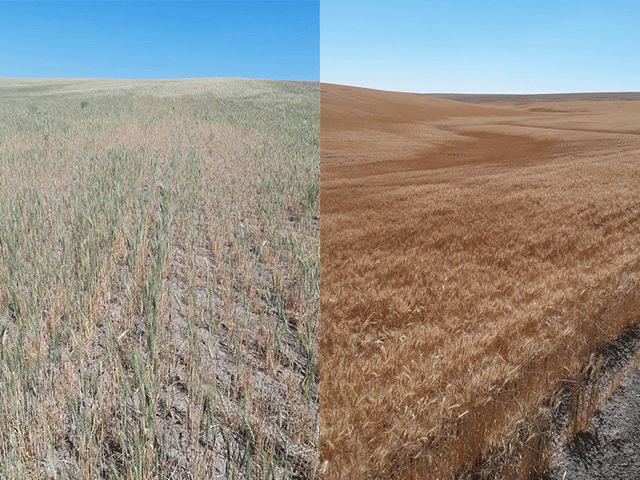Cash Market Moves
Drought, Heat Bake Pacific Northwest Soft White Wheat Crops
Winter and spring white wheat -- used in products such as cakes, cookies and pastries -- is getting baked this summer, but not in kitchens. The crops are getting baked in Pacific Northwest fields due to the extreme drought and record-high temperatures in the region this summer.
Soft white wheat (SWW) is used to make flour for bakery products other than bread, such as cakes, crackers, cookies, pastries, quick breads, muffins and snack foods. SWW also provides a whiter and brighter product for Asian-style noodles, making it a favorite for China. In fact, during the previous crop year, China purchased 39 million bushels (mb) of Pacific Northwest (PNW) SWW, and so far in the current crop year, they have about 8.3 mb on the books. They did buy 27 mb of spring wheat and 32.5 mb of hard red winter (HRW) wheat in the last crop year, but so far this crop year, they have minimal HRW wheat on the books. As a reminder, winter wheat crop year runs from May to May and spring wheat crop year runs from August to August.
SWW is both a winter and spring crop, but there is no distinction made between the two like there is with hard red winter versus hard red spring wheat. However, there are different varieties of soft white winter wheat and soft white spring wheat.
SWW is grown primarily in Idaho, Oregon and Washington, making for about 90% to 95% of the annual production. If you have been watching the drought map, you will see those states have been in an extreme drought for a very long time.
"Hot, dry weather following a parched fall and a winter with less snow in some areas has many parts of Washington, Oregon and Idaho experiencing some of the driest weather in a generation," said U.S. Wheat Associates analyst Michael Anderson. "Much of the area that grows spring and winter soft white and white club wheat is experiencing some form of drought."
P[L1] D[0x0] M[300x250] OOP[F] ADUNIT[] T[]
In the most recent Crop Progress report, USDA noted that 95% of Oregon's crop is headed, with 94% in Washington and 65% in Idaho. Only 18% of the PNW soft white crop is rated good to excellent. USDA's latest topsoil moisture ratings show Oregon at 86% short to very short, Washington 89% short to very short and Idaho 64% short very short.
To add to the misery of the farmers there, the Pacific Northwest, over a four-day period from June 26-29, likely experienced its worst heat wave in the region's modern records, adding to the already severely drought stressed wheat and other crops. (https://www.dtnpf.com/…)
"The last time the crop conditions were nearly this bad was the crop year of 1977," said Ron Mielke, Harrington, Washington. "That year, the weather turned hot in May, June and July to damage the crop. This calendar year, we have only had 2.64 inches of rain to date and only 0.57 inch for the last 140 days of spring. Add historic high temperature records to the drought, and our winter wheat and spring wheat have really suffered."
Mielke said that most of the soft white winter wheat crops will be harvested since they had some of last year's moisture to survive on, but the spring crops that were planted have had no significant rainfall since planting. "There are some spring wheat fields in Adams County and some in Lincoln County that will not go to harvest. Our soft white spring wheat crop may be 15 bushels per acre, and we are planning to harvest, but crop insurance will be collected.
"Harvest will be tough to do; even the winter wheat height varies so much. It will be a tiring harvest. We have auto-header-height John Deere headers that will help. The spring wheat will require the header near the ground for all 757 acres," added Mielke
Lane Hannas with Columbia Grain in Lind, Washington said: "All-time-record-high heat was set in several producing areas this last week of June. However, I don't see much of the crop being abandoned. Fall-planted SWW was healthy coming out of winter but has had almost no spring precipitation to reach its full yield potential. Spring planted SWW is going to suffer the most; establishment was difficult for many farms, and again, no additional moisture to help that crop finish. I have heard of some spring SWW being tilled under but not a significant amount of the crop by any means."
Hannas said that the industry expects the characteristics of this year's SWW crop to be lower than average in test weight and higher than average in protein as a result of the expanding drought. "In our export market, the optimum protein for SWW is between 9.0-10.5, so protein levels exceeding 10.5 will likely constitute discounts to this optimum range. We expect our harvest to begin next week, which is at least 10 days ahead of average."
Steve Matsen, Horse Heaven Hills, Washington, said that this is the second year for severe drought, and expecting a drop in SWW production of 80 mb might be optimistic. "It's so dry you can smell it. Harvest will be combine races -- get in, get out. There are already warnings from merchandisers that discounts for SWW greater than 10.5% protein will apply." (Drought wheat is historically high protein.)
"More of a concern to the area farmers now is that our summer fallow ground will not have enough seed-zone moisture in September to plant our soft white winter crop for 2022. The long-term forecast for our area is continued above-average temperatures and below-average rainfall," said Mielke. "That is what is so discouraging. I have never in my farming career faced a situation that I can't plant a winter wheat crop in September."
Mary Kennedy can be reached at mary.kennedy@dtn.com
Follow her on Twitter @MaryCKenn
(c) Copyright 2021 DTN, LLC. All rights reserved.



